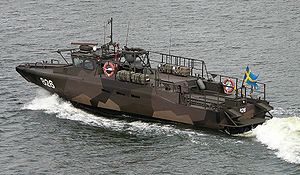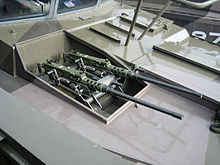- Combat Boat 90
-

Combat Boat 90Class overview Builders: Dockstavarvet, Gotlandsvarvet Operators: Swedish Navy, Royal Norwegian Navy, Mexican Navy, Malaysian Navy, Brazilian Army Preceded by: Tpbs 200 In commission: 1991 Completed: 250–300 General characteristics Displacement: 13,000 kg (28,660 lbs) Empty, 15,300 kg (33,730 lbs) Standard, 20,500 kg (45,190 lbs) Full load Length: 15.9 m (52') Overall
14.9 (48') WaterlineBeam: 3.8 m (12'6") Draught: 0.8 m (2'8") Propulsion: 2 x 625 bhp Scania DSI14 V8 Diesel; 2 x Kamewa FF water jets Speed: 40 knots (74 km/h) Range: 240 nmi (440 km) at 20 knots (37 km/h) Complement: 3 (two officers and one engineer)
Up to 21 amphibious troops with full equipmentArmament: 3 × Browning M2HB machine guns
1 × Mk 19 grenade launcher
4 naval mines or 6 depth chargesCombat Boat 90 (CB90) is a class of fast military assault craft originally developed for the Swedish Navy by Dockstavarvet. In addition to the many variants in service with the Swedish Navy under the Strb 90 H designation, the CB 90 has been adopted by the navies of several countries, including Norway (as the S90N), Greece, Mexico (as the CB 90 HMN), and Malaysia. Also the German Navy plans to equip the Berlin-class replenishment ships with the CB90.
The CB90 is an exceptionally fast and agile boat. Its light weight, shallow draught, and twin water jets allow it to operate at speeds of up to 40 knots (74 km/h) in shallow coastal waters. The water jets are partially ducted, which, along with underwater control surfaces similar to a submarine's diving planes, allows the CB90 to execute extremely sharp turns at high speed, decelerate from top speed to a full stop in 2.5 boat lengths, and adjust its pitch and roll angle while under way.
Contents
History
In 1988, Dockstavarvet won a competition to design and manufacture a replacement for the aging Tpbs 200 class. Two prototypes, with pennant number 801 and 802, were delivered in 1989. After completion of field trials, the Swedish Navy signed a purchase order for 120 boats in June 1990.
The official Swedish Navy designation is Strb 90 H (Stridsbåt 1990 Halv pluton, literally: Combat Boat 1990 Half platoon); the H refers to the fact that it can carry and deploy a half platoon of amphibious infantry (21 men) fully equipped.
In 2002, the Swedish Navy ordered an additional 27 boats of a slightly different type, designated Strb 90 HS, and intended for deployment in overseas peace-keeping operations. It is unclear what the S refers to; it may be short for Skyddad (protected), as the Strb 90 HS is armored. Apart from the addition of armor, the HS model features NBC warfare protection (the whole boat can be over-pressurized), air-condition for deployment in tropical conditions, fuel cooling system, 220V generator and more powerful engines. The factory sometimes refers to it as the CB 90 HI, where the I probably stands for International.
Several of the tasks carried out by the Strb 90 H-variants, were originally intended for the Strb 90 E, which is now almost completely phased out.
The Royal Norwegian Navy evaluated the Strb 90 H in early 1996, and subsequently purchased a total of 20 boats, designated 90 N (for Norsk utgave, literally Norwegian version).
The Mexican Navy acquired 40 units (designated CB 90 HMN) between 1999 and 2001, and obtained a production license in 2002, allowing further units to be manufactured in Mexico. Since then eight additional units have been built.
The German Water Police rented a Combat Boat 90H from the manufacturer Dockstavarvet for the 33rd G8 summit in Heiligendamm, Germany. This boat was involved in a high speed chase with three Greenpeace RIBs which were trying to enter the restricted area near the hotel where the meeting was being held. A video clip of the incident was later widely spread around the internet.[1][2]
In July 2007 The United States Navy Expeditionary Combat Command (NECC) specified the CB90 for testing as its Riverine Command Boat. Safeboat International of Port Orchard, Washington, was given a US$2.8 million contract to produce one prototype.
In June 2009 an unknown buyer from Abu Dhabi bought two civilian luxury versions. [3]
In 2010, Dokstavarvet Shipyard modified two CB90's to be carried in the davits of Dutch and UK Navy LPD's. During these six months trials, the two boats and a full Swedish boat squadron will be embarked on a Royal Netherlands Navy LPD as a fully integrated element of the amphibious forces aboard and be deployed.
Versions
Several Strb 90 H have been converted by the Swedish Navy to fill various roles:
- The Strb 90 L is outfitted for battalion-level command and control, with computer and communications equipment and an auxiliary generator to provide electrical power when the engines are not running. The L stands for ledning (command or leadership).
- The Strb 90 KompL is a plain Strb 90 H in which portable computer and communications equipment has been installed, allowing it to temporarily provide company-level command and control. Electrical power is provided by a rather loud portable generator installed on deck.
- The Strb 90 HS is designed for overseas peace-keeping and rescue operations. It is modified to keep its crew comfortable in Mediterranean conditions, with air conditioning, an auxiliary generator, a head, and more comfortable crew stations. More importantly, it is armored, and its engines have been upgraded to compensate for the added weight.
- At least one Strb 90 H, pennant number 802, is equipped with a decompression chamber.
- The Swedish Police operate one unarmed Strb 90 H equipped with bunks, a pantry and a crew lounge.
- The Swedish Sea Rescue Society operates two unarmed Strb 90 Hs converted for search and rescue.
- Hellenic Coast Guard operate also since 1998 three CB90 under the CB90HCG which is a slightly different version of the Norwegian Navy Version
The Royal Norwegian Navy operates 20 CB90s under the designation SB90N; the N simply stands for Norsk utgave (Norwegian version). The S90N differs from the Strb 90 H in a few areas:
- It is armed with only one 12.7 mm machine gun, instead of three.
- The anchor winch is motorized, and the anchor is mounted at the stern, allowing a grounded S90N to tow itself afloat rather than risk damage to its impellers.
- It carries an auxiliary generator which provides electrical power to navigation and communications systems even when the engines are not running.
- The "Troops transportation room" has a higher deck height, making it possible for most people to stand without crouching.
- It has two water tight compartments in the bow, having an extra room for toilet and stores.
- It has a much more sophisticated navigation equipment based on GPS-technology delivered by Kongsberg Seatex AS.
At least one S90N has been reconfigured into a floating ambulance.
In 2004, the Royal Norwegian Navy conducted tests (including a live fire exercise) to evaluate the effectiveness of the SB90N as an aiming and launching platform for the Hellfire missile. One SB90N was equipped with stabilized Hellfire launcher based on the PROTECTOR M151, and its machine gun was replaced with a gimbal-mounted sensor package containing visible-light and infrared cameras and a laser designator. Although the tests were successful, there is currently no indication that the Royal Norwegian Navy will actually deploy SB90Ns armed with Hellfire missiles in regular service. The Hellfire can still be carried on the boats without launching platforms and be fired from shore with the Portable Ground Launch System.
Accidents involving CB90s
On the night of October 23, 2006, a CB90 sank off of Hamnudden, east of Utö in the Stockholm archipelago. The boat was traveling at 11 knots (20 km/h) due to the bad weather when it suddenly began to take on water from the bow. It then sank in less than ten minutes. All of the crew of 16 were quickly picked up by other ships that were nearby. No one was physically injured, but the crew suffered from shock and hypothermia when picked up.
On June 13, 2004, several Strb 90 H from the Swedish Navy's first amphibious regiment(AMF1) were sailing at high speed in convoy formation when one of them abruptly reduced speed (allegedly so its wake would not upset a smaller sailboat). The boat immediately behind it failed to react and rammed it. Two soldiers who were above deck at the time of the accident were thrown in the water; one was killed instantly, and the other sustained severe injuries from which he died later the same day.
In mid-1999, one CB90 (No. 820) belonging to the 2nd Coastal Artillery Regiment (KA2) of the Swedish Navy crashed into a concrete pier at approximately 30 knots (56 km/h). There were eight soldiers on board; seven of these men sustained more or less severe injuries, including fractures, while one soldier who remained physically unhurt was standing in the machine gun ring-mount on mid-deck.
Operators
 US Navy Riverine Squadron small unit riverine craft (left) and a Riverine Command Boat (right), 2011
US Navy Riverine Squadron small unit riverine craft (left) and a Riverine Command Boat (right), 2011
 Greece
Greece- Hellenic Coast Guard: 3
 Malaysia
Malaysia- Malaysian Navy: 5 unit CB90, 12 unit CB90HEX, mostly station in East Malaysia (Sabah & Sarawak)
 Mexico
Mexico- Mexican Navy: 48
 Norway
Norway- Royal Norwegian Navy: 20
 Sweden
Sweden- Swedish Navy: 200
 United States
United States- US Navy: 2, known as 'Riverine Command Boat'[4][5]
Related development
References
- ^ SvD article
- ^ Greenpeace-Boote dringen in G-8-Sperrzone ein [1]
- ^ Di article
- ^ Andrew Scutro (August 2, 2007). "New riverine boats are fast, lethal, flexible". Navy Times. http://www.navytimes.com/news/2007/08/navy_attackboat_070801/. Retrieved 2010-11-15.
- ^ US Navy (September 25, 2009). "Image: 090925-N-9095H-025.jpg". US Navy News. http://www.navy.mil/view_single.asp?id=81689. Retrieved 2010-11-15.
- (Swedish) Stridsbåt 90H at SoldF.com, an unofficial site dedicated to information about Swedish military materiel.
- (Norwegian) Et fremtidsrettet prosjekt, an article about the Hellfire experiment on the official web site of the Norwegian military.
- (English) A series of pictures of a Norwegian S90N
External links
- Video of CB90 in action on the Amazon River (Windows Media Player) Note: Commercial video, but shows the boat’s capabilities.
- (YouTube) CB 90 Hellfire Trials .
Categories:- Small combat vessel classes
- Ships of the Royal Swedish Navy
- Active ships of Sweden
- Ships of the Royal Norwegian Navy
- Patrol vessels of the Hellenic Coast Guard
- Riverine warfare
Wikimedia Foundation. 2010.


